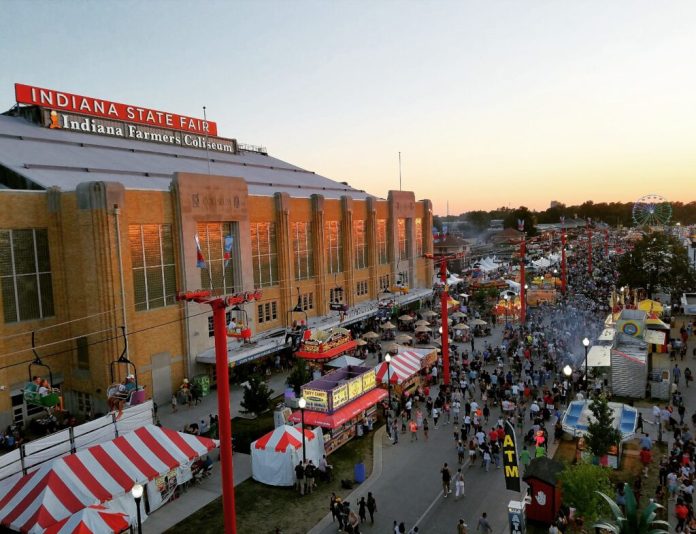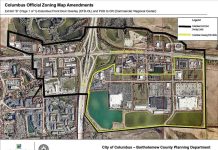
| Indiana Capital Chronicle
For The Republic
INDIANAPOLIS — Contention over who runs the Indiana State Fair — with roots in a legal change made three decades ago — emerged during the legislative session in a spat about fair date language added, removed and re-inserted into a proposal in the hours before Sine Die.
Ten words slipped into the 112-page House Enrolled Act 1120, a property tax turned administrative bill, give Indiana’s finance-oriented State Fair Commission the power to set fair dates, and strip that authority from the fair-focused State Fair Board.
The commission maintains that the change is fiscal in nature, but board supporters say it’s a step toward “takeover.”
“It is a fiduciary decision,” said Anna Whelchel, spokeswoman for the Indiana State Fairgrounds & Event Center. She said the edit ensures consistency in the fairgrounds’ governance structure.
But Sen. Jean Leising, R-Oldenburg, said the board “was definitely slighted by this. What seems like a simple little change in a multi-page bill (is) not maybe as simple as what everybody thinks.”
Lasting impacts of decades-old reorganization
It’s not the state’s first change in approach.
A nascent Indiana — just 35 years into statehood — created the State Board of Agriculture in 1851. The following year, Indiana hosted its first state fair, becoming just the sixth state in the nation to do so, according to IUPUI’s University Library.
The Board of Agriculture ran fair operations until 1925, when Indiana lawmakers created the State Fair Board, according to IUPUI’s Polis Center. They established a new version of the board in 1947.

But over the ensuing decades, fair facilities deteriorated amid financial struggles.
Lawmakers in 1990 created the State Fair Commission to operate the fairgrounds year-round and keep the property on firm financial footing. The commission has nine voting members: five gubernatorial appointees, two board representatives, the Indiana State Department of Agriculture (ISDA) director and the Purdue University Extension leader.
That move also abolished the old board in favor of an advisory version beneath the commission that retains some authority over fair minutia. The 17-member fair board has seven elected members — one from each district in ISDA-run elections — as well as seven appointed members and three permanent members. They include the governor, ISDA director and Extension leader.
The changes fomented a power struggle still happening today.
Legislative back-and-forth
The fairgrounds now hosts more than 400 events annually, with 2 million visitors, according to a commission governance manual. But the State Fair is still its “largest customer.”
Fair dates can have major impacts on the farmers and others participating in the fair, as well as on who visits, those involved say.
Commissioners and board members skirmished over this year’s fair dates in a joint October meeting, according to Leising — but the board won out. Meeting minutes were not immediately available.

Rep. Bob Cherry, R-Greenfield, introduced the date-setting change in an amendment to an agricultural bill in late January.
He said because the commission is responsible for “the financial side of it,” the body needed the power to ensure “the dates are fit.”
“We don’t want to have, say, a shortfall,” Cherry said. The retiring lawmaker leads the State Fair Advisory Committee – a third entity.
That brought an outpouring of worry from board members and 4-H fans to Leising, who is the advisory group’s vice chair. She amended Cherry’s change out of the legislation a month later, when it reached her agriculture-focused committee.
State Fair Board member Terry Strueh testified that he’d had “extensive communication” with the other members and said those with which he’d spoken were “very supportive.” Strueh, who wasn’t available for comment, contended the board “is the best entity to make that decision.”
But on the last day of session, the language reappeared, tucked in omnibus legislation that made it into law.

“This is only the beginning, if not the total, takeover of the State Fair Board and authorities by the commission,” Leising said on the Senate floor. She voted against the bill, commenting that otherwise, “I might get tarred and feathered in my district.”
The fairgrounds’ Whelchel rejected the assertion.
“That is not accurate at all,” she said. “The commission’s charge and … obligation is to make the Indiana State Fairgrounds and the Indiana State Fair a success.”
“We work collaboratively — as a commission, as a board, as a staff — and we all have the end goal of preserving and enhancing this state institution and making it better for all the citizens of Indiana,” Whelchel added.
Change’s effects
The fair’s dates have had “many iterations,” particularly around the pandemic, according to Whelchel.
“We’ve been 12 days, we’ve been 17 days,” she said. “We then were 18 days these last three years and now we’re back to 15 days. Regardless of the format, the commission, board and staff are all working collaboratively.”
“What date format gives the fair the greatest opportunity for success? And specifically, success when it comes to the financial side of it, to make sure that we are a healthy and a fiscally responsible State Fair commission,” Whelchel continued.
Weekends are the best revenue days because visitors are out of work and out of school, so they’re able to come to the fair, she noted. That’s why the commission has previously pushed for longer fairs with more weekend days, and two weekday closures.
Leising, the board’s most outspoken advocate during the session, said that a stretched-out setup complicates animal-related logistics for vendors.
“It just doesn’t work as well,” Leising said. “And I know that as they extend the fair dates (earlier), … some of the county fairs are not even hardly over when the state fair starts.”

Leising said she’d “always” side with elected officials responsive to their constituents. Board members, she said, “are the ones that understand agriculture.”
“They understand 4H, they understand the whole business of livestock showing. I would tell you that most of the members on the commission, probably, that would not be their primary interest in the fairgrounds,” she said.
At least two of the five gubernatorial appointees to the commission must have a “recognized interest” in agriculture or agribusiness, according to the governance manual, but all seven board appointees must demonstrate such interests under code.
Whelchel, however, said the commission has “no interest” in changing the dates for now.
“We’re committed to this format. That decision was made and the staff and everybody is working to make it work,” she said.
“If for some reason this format does not turn out to be successful, the commission will will have the authority to decide if they stay with it or not,” she added. “But we have been very, very clear with each other that it does none of us any good … to keep changing dates around. So our 100% focus is making this format a success.”
— The Indiana Capital Chronicle covers the state legislature and state government. For more, visit indianacapitalchronicle.com.




